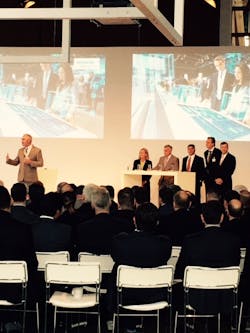Here’s a number that will wake you up: $2.2 trillion. That’s how much companies could add to the Gross Domestic Product (GDP) by 2025 if they were to digitalize their operations, according to McKinsey Global Institute. The bottom line being that digital assets create a competitive advantage as it reduces product time-to-market, creates energy efficiency, improves quality—and ultimately brand loyalty.
These were the topics discussed by Siemens industry executives during a thought leadership panel at Hannover Messe this week. Siemens outlined its Digital Enterprise portfolio and how the convergence of virtual and physical environments will accelerate manufactures’ move toward Industry 4.0.
Over the last decade, Siemens has spent billions of dollars acquiring companies and developing technology for the “digital twin,” an electronic version of a physical asset used to map product design, engineering and production execution through simulation and services.
It is an important step toward manufacturing modernization as companies attempt to sunset legacy systems that are not agile or adding any more value.
“This aging asset topic is real,” said Raj Batra, President of Siemens Digital Factory in the U.S. “It’s reported that three quarters of our plants in the U.S. are over 25 years old and 35% of those assets are aging. Here, modernization is needed and there are big productivity advantages.” For example, digitization can lead to a 30% reduction in the engineering of products and about a 50% reduction in time-to-market.
And while many companies struggle with where to start, Batra advises this doesn’t have to be deployed in the same way as a massive ERP project, rather, it can be done in stages. And, the most important first step is to unify the data sets.
In a subsequent presentation by Siemens CTO Bernhard Quendt, he reinforced the concept of using the same data sets from construction to planning to production. This set up connects real data back to simulation and ultimately the digital data.
“We closed the loop between the real world and the virtual world,” Quendt said.
To do that, Siemens has created a data modeling tool that is integral to the original product design and translates to the rest of the process. Furthermore, it does not all have to be Siemens products for this to work, as there are exporting functions and standards to support third party suppliers, he said.
The companies adopting the technology are experiencing enormous benefits. Like, a BMW plant in China that was able to assemble five different types of cars on the same production line.
And, while the digital factory theme seems to focus on discrete manufacturing, digitalization applies to process and hybrid industries, as well, Quendt said. While there may be different systems—such as for a chemical process—the underlying way to exchange digital information is the same.
So the final question of the day to Quendt perked up the room (just as much as the $2.2 trillion did), and that was: “What does Industry 5.0 look like?”
While Quendt admitted he doesn’t have a crystal ball, he took a good guess that the level of connectivity, data exchange and cloud-based services will increase more. He also said that data plays a major role for the future. “The things you can do and deduce out of data will be more important and enable us to do things we can’t imagine today.”

